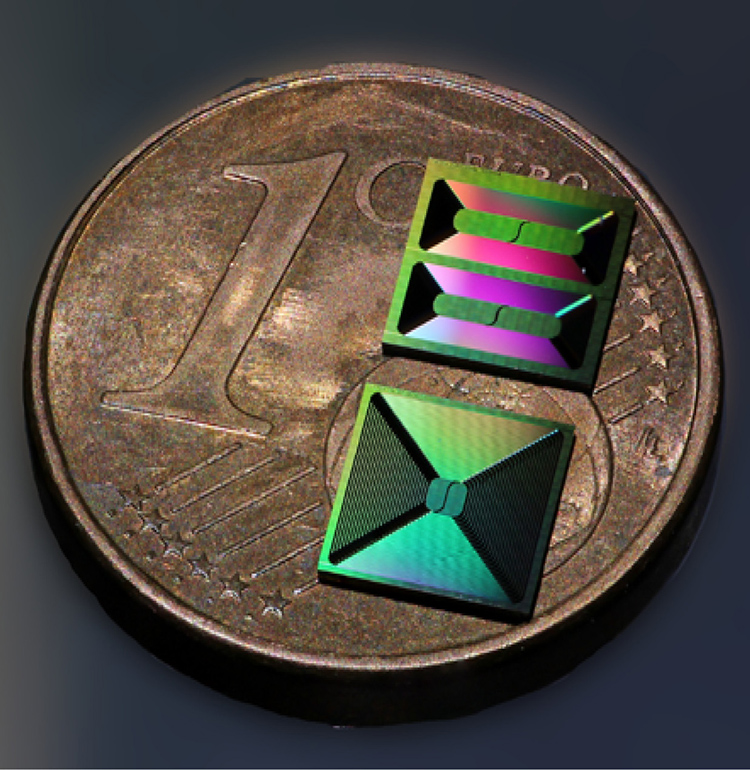 Photograph showing Si3N4 photonic chips containing two meter-long (upper chip) and one 1.4-meter-long (lower chip) spiral waveguides.
Photograph showing Si3N4 photonic chips containing two meter-long (upper chip) and one 1.4-meter-long (lower chip) spiral waveguides.
Silicon photonics has evolved into a mature technology enabling on-chip generation, modulation, and detection of optical signals, via heterogeneous or hybrid integration of different materials. In the last 20 years, silicon photonics has been transferred to large-volume deployment in data center interconnects. Low-loss photonic integrated circuits and microresonators are key building blocks for narrow-linewidth lasers1 and chip-scale frequency combs.2
To translate these applications into a widespread technology, attaining ultra-low optical losses with established foundry manufacturing is critical. Silicon nitride (Si3N4) has emerged as the material of choice for this purpose in view of its wide transparency window, absence of two-photon absorption, strong Kerr nonlinearity, high refractive index and high power-handling capability.
Recent advances in integrated Si3N4 photonics have shown that ultra-low-loss, dispersion-engineered microresonators with quality factors Q > 1×107 can be attained at die-level throughput. Yet current fabrication techniques lack sufficiently high yield, performance and reproducibility for existing and emerging applications, such as integrated travelling-wave parametric amplifiers that require meter-long photonic circuits.3
In work published this year, we demonstrated a fabrication technology that meets all requirements on wafer-level yield, performance and length scale.4 We obtained photonic microresonators with a mean Q factor exceeding 3×107, corresponding to 1.0 dB/m optical loss, over full four-inch wafers, as determined from a statistical analysis of tens of thousands of optical resonances, and confirmed via cavity ringdown with a 19-ns photon storage time. Our fabrication process operates over large areas with high yield, enabling meter-long spiral waveguides with 2.4 dB/m loss in a 5×5 mm2 die size.
Using a response measurement self-calibrated via the Kerr nonlinearity, we showed that the intrinsic absorption-limited Q factor of our Si3N4 microresonators can exceed 2×108. This absorption loss is sufficiently low such that the Kerr nonlinearity dominates the microresonator response even in the audio frequency band.
We believe that transferring the silicon nitride photonics technology that we have developed to standard foundries and merging it with silicon photonics using heterogeneous integration will significantly expand the scope of today’s integrated photonics and seed new applications.5
Researchers
Junqiu Liu, Guanhao Huang, Rui Ning Wang, Jijun He, Arslan S. Raja, Tianyi Liu, Nils J. Engelsen and Tobias J. Kippenberg, Swiss Federal Institute of Technology Lausanne, Lausanne, Switzerland
References
1. W. Liang et al. Nat. Commun. 6, 7371 (2015).
2. A.L. Gaeta et al. Nat. Photon. 13, 158 (2019).
3. M. Pu et al. Laser Photon. Rev. 12, 1800111 (2018).
4. J. Liu et al. Nat. Commun. 12, 2236 (2021).
5. C. Xiang et al. Science 373, 99 (2021).
